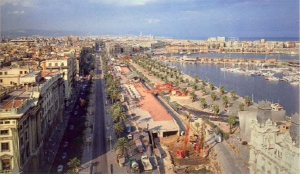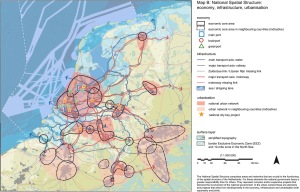I. Urban Planning
City Planning or Urban Planning, the unified development of cities and their environs. For most of its history, city planning dealt primarily with the regulation of land use and the physical arrangement of city structures, as guided by architectural, engineering, and land-development criteria. In the mid-20th century it broadened to include the comprehensive guidance of the physical, economic, and social environment of a community. Elements characteristic of city planning include (1) general plans that summarize the objectives of (and restraints on) land development; (2) zoning and subdivision controls that specify permissible land uses, densities, and requirements for streets, utility services, and other improvements; (3) plans for traffic flow and public transportation; (4) strategies for economic revitalization of depressed urban and rural areas; (5) strategies for supportive action to help disadvantaged social groups; and (6) guidelines for environmental protection and preservation of scarce resources. City planning is conducted by governments on all levels—local, country, regional, state, and federal—and by private groups.
The Netherlands is a small, low lying and densely populated country (population 16.3 million) which is known for being neat and tidy and relatively classless. This is often attributed to the ‘polder mentality’ of people having to collaborate to maintain the dykes that keep out the sea. There has been a tradition of discouraging urban sprawl, especially into the area between the four big cities through voluntary collaboration between local authorities. Concern to reduce travel by car (and to encourage walking, bicycling and the use of public transport) has reinforced the commitment to ‘compact cities’. Furthermore, a national priority has been to upgrade the centres of the main cities in the belief that they act as dynamos for their wider city-regions.
Urban Renewal
Following the housing shortages caused by the war and the influx of immigrants, the government undertook an extensive house building programme. Quickly a need to focus on inner urban areas appeared. In Rotterdam a group of elected politicians led the way by setting up local urban renewal organisations and campaigning for government-funded ‘renewal areas’ to be created. This policy was largely successful and by 1996 more than 50% of the housing stock in the renewal areas (including parts of Feyenoord) had been modernized. However this policy did not tackle unemployment of the wider social aspects of urban living. Eventually the mayors of the four large cities collectively lobbied the national government for greater support for a broad-ranging approach to urban renewal. This led to the Major Cities Policy (Grote Steden Beleid) which aimed at creating a ‘complete city’ through economic, social and physical measures and had a bottom-up approach to implementation. The outcome was a five-year funding agreement between the central government and the local authorities (municipalities) in each of the four cities, including Rotterdam. The first agreements were made in 1994. There have been two further 5-year agreements since, and the number of participating towns has increased to thirty. Each agreement sets out an agreed strategy and a financial commitment from the national government. The implementation programme is drawn up by the municipality concerned and includes a limited number of output targets. When agreement has been reached, the municipality accepts responsibility for the implementation of the programme and for the success of their town. This represents an important devolution of power and responsibility.
Historically the Netherlands used to be a decentralised state, with a strong stress on local collaboration (the so-called ‘polder mentality’). Although the autonomy of local authorities had been gradually reduced during the late 19th and early 20th centuries, they still retained significant roles. After World War II, the call for a larger welfare state, and the need for large scale provision of housing and the repair of damaged urban areas, resulted in more power, and a greater share of financial resources, being taken by the central government. However, during the 1990s there was a reduction in state intervention in welfare and housing (including, for example, the promotion of owner-occupation), and a move to give more responsibilities back to local authorities so that they could make decisions and integrate activities at a more local level. The Major Cities Policy is an example of this.
The result is that municipalities can be flexible in the way that they implement national policies. Central government sets the policy framework, and local authorities implement the policies in the way that best fits local circumstances. This flexibility allows local authorities to take a more proactive and entrepreneurial approach in both planning and policy implementation. In Rotterdam this has led to an ‘Integrated Area Approach’ which focuses on priority areas and tackles local employment and quality of life issues as well as making physical improvements. Great stress is now placed on ‘working together’ – involving residents, landowners, businesses, local politicians, local agencies such as housing associations etc – and on communication. Social inclusion is also given a high priority, especially because of the large number of immigrants in the city.
Another important characteristic of the ‘Dutch approach’ is the ability and willingness to work through informal networks. As in Sweden and Northern France (which is Flemish in origin) the concept of working together, across professions and sectors, towards the common good is widely accepted. This appears mainly to take place in a voluntary way. Although there are many formal partnerships, it is not just the structures that are important but the attitudes of the parties involved and their ability to be flexible and co-operate at a practical level.
The Netherlands, however, does not have a formal ‘city-region’ layer of government. An experimental Rijnmond Region around Rotterdam was tried, but it failed – partly because of confusion over its role in co-ordinating policies among municipalities, and partly because it would create a fourth tier of government. A referendum was held on whether there should be a formal city-region, but this was rejected. However, the municipalities recognize that they need to co-operate in order to promote economic competitiveness and so informal city-regions (in which the individual municipalities keep their independent identities) have in fact developed around the major cities. There is also increasing collaboration across the Randstad (‘Regio Randstad’) with a view to increasing its overall international competitiveness too.
Delft, January 2007





